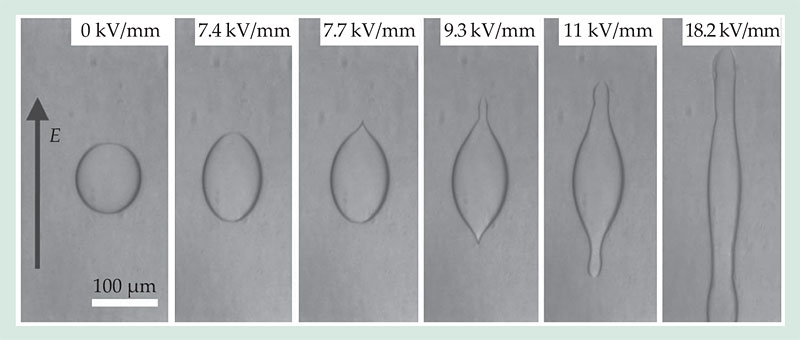Droplets deform in a solid at high voltage
DOI: 10.1063/PT.3.1841
Fluid droplets form spheres to minimize their surface energy. But when electrified in a surrounding gas or liquid—in a thunderstorm cloud, say, or an inkjet printer—they can become unstable and deform into cones that emit streams of smaller droplets. G. I. Taylor explained the phenomenon in 1964, and it has been extensively explored and exploited ever since.
The behavior of electrified droplets in an elastic solid, in contrast, has remained largely mysterious. For one thing, solids usually suffer electric breakdown at field strengths comparable to those required to trigger an instability in a trapped water drop, air bubble, or other fluid inclusion. For another, soft dielectric polymers—an important class of materials that commonly contain such defects—also change shape in an electric field (see the article by Siegfried Bauer, Reimund Gerhard-Multhaupt, and Gerhard Sessler in Physics Today, February 2004, page 37
Researchers Qiming Wang, Xuanhe Zhao (both at Duke University), and Zhigang Suo (Harvard University) have now cleverly sidestepped both obstacles and made the first observations of highly charged, deforming droplets in a solid polymer. 1 To do so, they sandwiched a millimeter-thick layer of saltwater-laden silicone rubber between two rigid insulating plates coated with transparent electrodes. The plates suppressed the polymer’s overall deformation and prevented it from shorting out in high fields. With that setup, the researchers used optical microscopy to monitor the embedded water droplets’ behavior as a function of electric field.
As the voltage across the layer was ramped up to a few kilovolts, the team noticed individual droplets elongate from sphere to ellipsoid along the field direction as oppositely charged saltwater ions accumulated on opposite ends of a drop. At a critical field strength, the droplet was observed to undergo abrupt instabilities, manifest as the sharp tips in the middle two panels of the figure. If the field was turned off after reaching 7.7 kV, the droplet assumed its original shape. But further increasing the field strength created electrostatic stresses high enough to fracture the polymer as the droplet was stretched into a long tube.

A spherical droplet of conductive saltwater embedded in silicone rubber gradually deforms into an ellipsoid as an electric field E is ramped up to a few kilovolts per millimeter. The droplet then suddenly undergoes instabilities, seen as the sharp tips at opposite apexes of the droplet. Further increases in field strength pull it apart with enough electrostatic force to crack the surrounding solid.

What’s more, the droplets didn’t behave independently but interacted with their neighbors to enhance the local electric field between them—and thus lower the critical field needed to destabilize each one. Zhao and his colleagues argue that their observations support a previously unrecognized mechanism by which a polymer can fail: Pervasive instabilities and microscopic cracks initiated at droplet defects under high voltage—in a power-grid capacitor, insulating cable, or squeezable transducer, say—contribute to the material’s eventual dielectric breakdown.
To test that hypothesis, the researchers turned to a more traditional experiment: measuring the breakdown fields of silicone rubber containing various volume ratios of saltwater droplets. Concentrations as low as 1% turned out to significantly reduce the dielectric-breakdown threshold. Interestingly, a similar reduction in breakdown field occurred when small concentrations of air bubbles (instead of saltwater) were mixed into the rubber.
Fortunately, one can design materials robust enough to withstand high voltages. The electrostatic stresses that drive a droplet’s deformation are resisted by the surface tension of the fluid and the elasticity of the solid. A polymer’s elastic stress far exceeds the pressure from surface tension, and the researchers found that the critical electric field scales with the square root of the shear modulus, a measure of stiffness. The stiffer the polymer, the greater the field required to make a droplet unstable and the more resistant the solid is to dielectric breakdown.
Even so, some applications call for designing softer, not stiffer, polymers, and others might benefit from the presence of at least some concentration of conductive-liquid droplets—to increase the material’s dielectric constant, for example, and thus its energy density.
Zhao says his group is pursuing a different type of project: “By controlling a droplet’s deformation at field strengths where it remains stable, we are building inexpensive tunable lenses.”
References
1. Q. Wang, Z. Suo, X. Zhao, Nat. Commun. 3, 1157 (2012).https://doi.org/10.1038/ncomms2178
